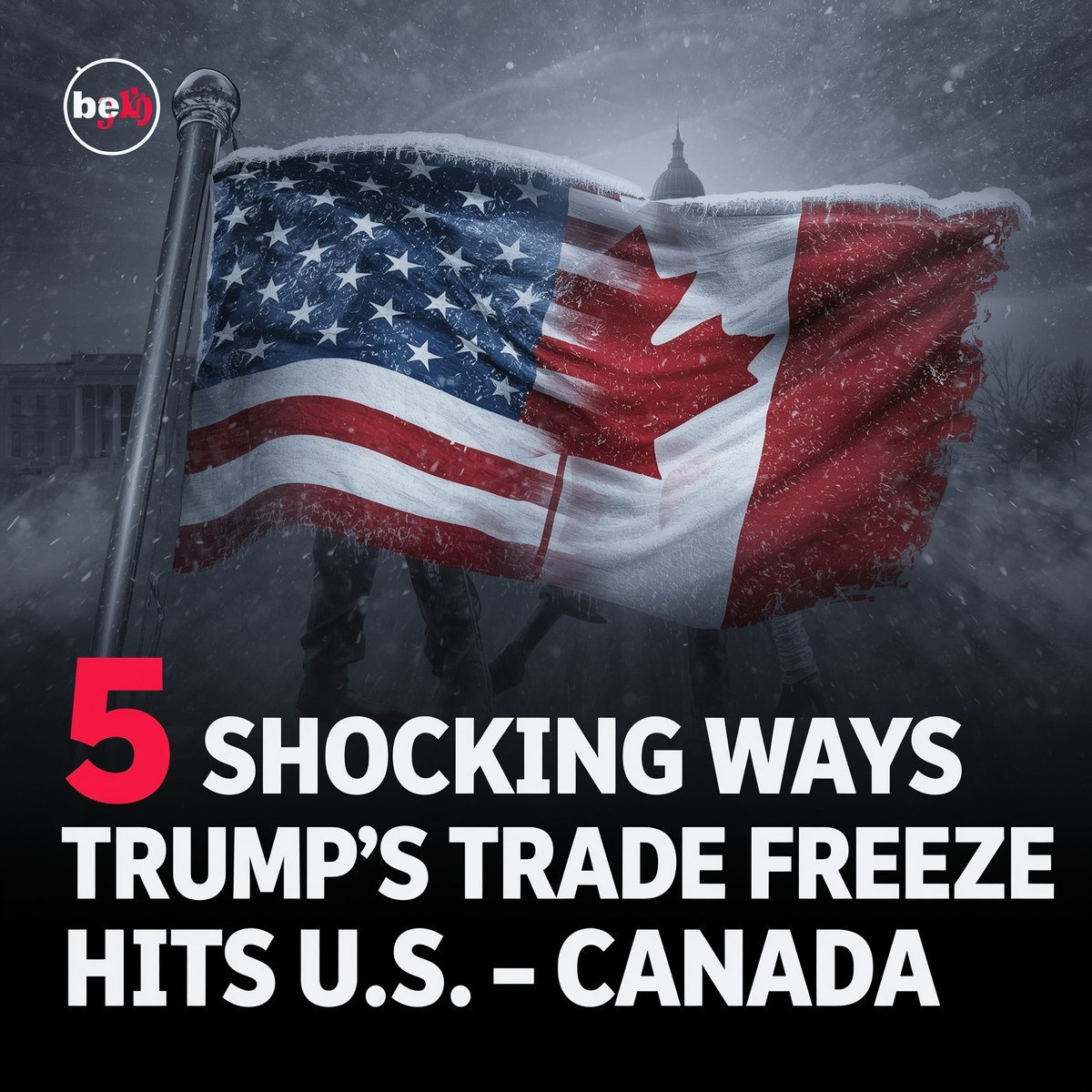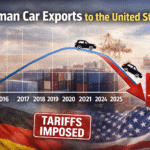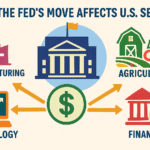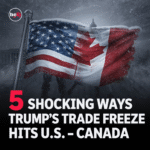In a sudden and dramatic move, President Donald Trump announced ( Trump’s Trade Freeze) Thursday night that he was terminating all trade negotiations with Canada, citing a controversial advertising campaign from the province of Ontario that used archival audio from former President Ronald Reagan to criticize U.S. tariffs.
The decision has thrown one of North America’s most important trade relationships into uncertainty, just as the two countries were preparing to revisit key terms of the U.S.–Mexico–Canada Agreement (USMCA). With over $500 billion in annual trade between the United States and Canada, the fallout could ripple through manufacturing, agriculture, and financial markets on both sides of the border.
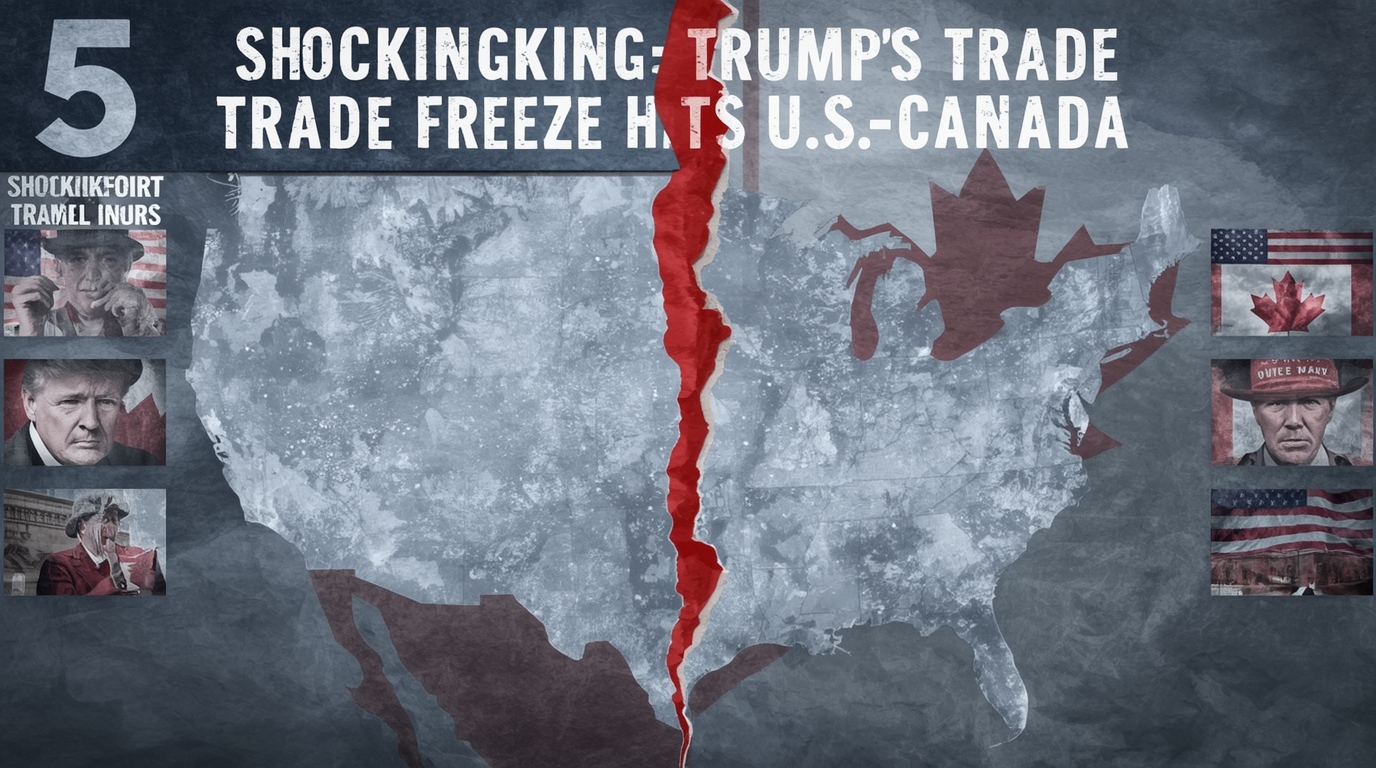
Table of Contents
A $75 Million Ad Sparks a Diplomatic Firestorm
The controversy centers on a $75 million Ontario ad campaign, launched during the Major League Baseball playoffs, aimed at U.S. audiences. The ads featured authentic audio from a 1987 radio address by Ronald Reagan in which he spoke out against tariffs and trade restrictions.
The province’s goal was to underscore the importance of open markets and warn U.S. voters about the potential harm of new American tariffs on Canadian autos and steel. Ontario Premier Doug Ford promoted the campaign on social media, declaring, “Using every tool we have, we’ll never stop making the case against American tariffs on Canada.”
However, the Ronald Reagan Presidential Foundation and Institute quickly objected. In a statement on X (formerly Twitter), the foundation said the ad “misrepresents the Presidential Radio Address to the Nation on Free and Fair Trade” from April 25, 1987, and noted that Ontario had not received permission to use or edit the remarks. The foundation said it was reviewing “legal options.”
Within hours, Trump responded on his social media platform, calling the ad “FAKE” and accusing Canada of interfering in U.S. court decisions, including an ongoing Supreme Court case involving trade authority.
Trump’s Reaction: “Egregious Behavior” and National Security
Trump’s statement was characteristically direct:
“The Ronald Reagan Foundation has just announced that Canada has fraudulently used an advertisement, which is FAKE, featuring Ronald Reagan speaking negatively about tariffs,” he wrote.
“They only did this to interfere with the decision of the U.S. Supreme Court, and other courts. TARIFFS ARE VERY IMPORTANT TO THE NATIONAL SECURITY, AND ECONOMY, OF THE U.S.A. Based on their egregious behavior, ALL TRADE NEGOTIATIONS WITH CANADA ARE HEREBY TERMINATED.”
The White House later confirmed that all working-level discussions related to the USMCA review, originally scheduled for early November, were suspended indefinitely.
The decision caught many U.S. and Canadian officials off guard, including Prime Minister Mark Carney, who had met with Trump earlier this month in an attempt to ease tensions. Carney’s office did not immediately comment but reaffirmed Canada’s intention to “pursue constructive engagement with all trading partners.”
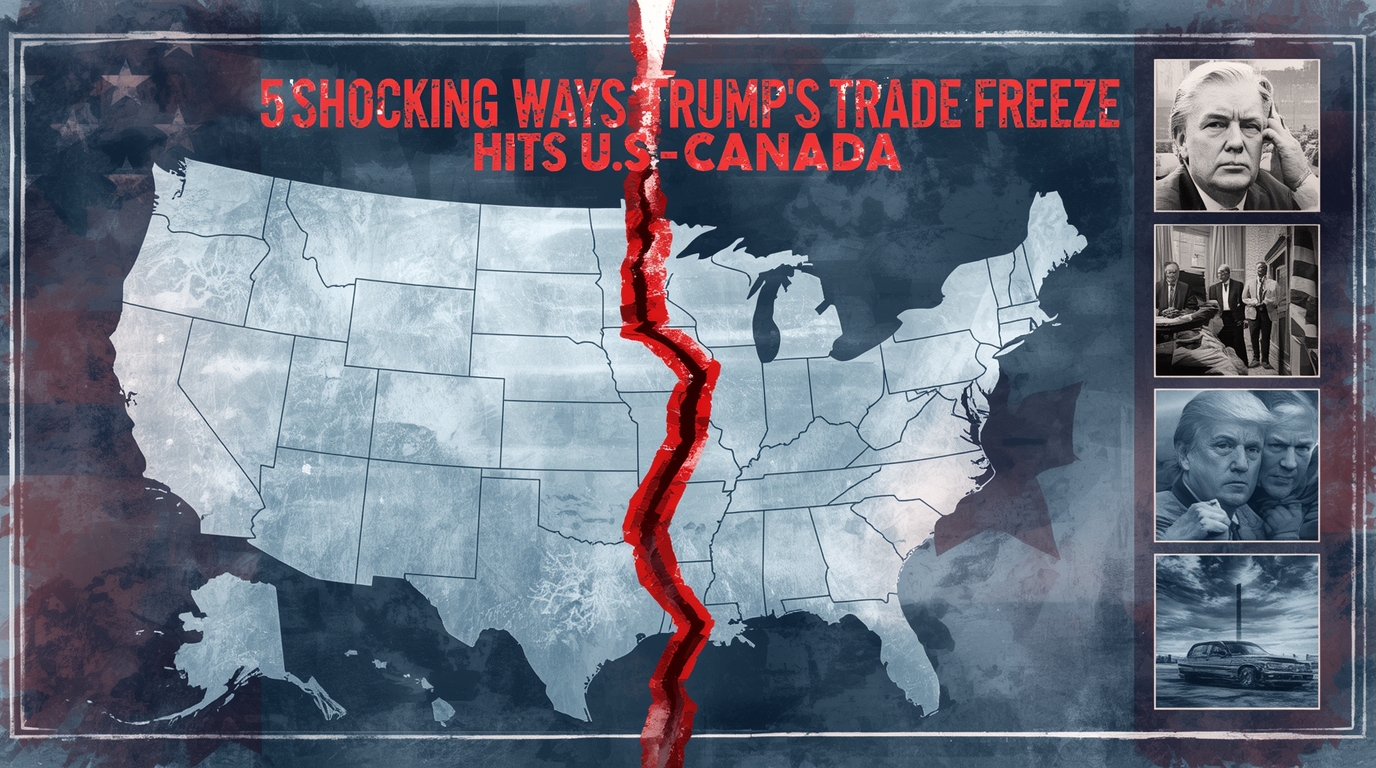
The Economic Stakes: $500 Billion in Trade and Millions of Jobs
The U.S. and Canada share one of the largest trading relationships in the world. Nearly three-quarters of Canadian exports go to the United States, while American companies depend heavily on Canadian raw materials, auto parts, and energy imports.
Every day, roughly $2.7 billion in goods and services cross the border. The U.S. Census Bureau estimates that Canadian imports support over 500,000 American jobs, particularly in border states like Michigan, New York, and Ohio.
Key Sectors at Risk-Trump’s Trade Freeze
- Automotive Manufacturing:
Ontario’s auto sector is closely integrated with U.S. supply chains. Tariffs as high as 25% could disrupt just-in-time manufacturing, increasing costs for automakers like Ford, General Motors, and Stellantis. - Steel and Aluminum:
Trump’s renewed focus on tariffs mirrors his earlier moves during his first term, when he imposed duties on Canadian steel and aluminum under Section 232 of the Trade Expansion Act, citing national security. Canada retaliated with levies of its own, targeting U.S. products from orange juice to motorcycles. - Agriculture and Energy:
Canadian agricultural producers depend on U.S. markets, while American energy firms rely on Canadian crude imports, particularly from Alberta. New trade frictions could affect fuel prices and food costs across North America. (Trump’s Trade Freeze)
Economists warn that the termination of negotiations could raise consumer prices in the U.S. and slow growth in both economies. Dr. Laura Chen, a senior trade economist at the Peterson Institute, told CFOS Times:
“The U.S. economy is already feeling inflationary pressures. Any renewed tariff conflict with Canada will likely add costs to manufacturing inputs, transportation, and consumer goods.”
Political Undercurrents: Trade, Courts, and Campaigns
Trump’s statement accused Ontario’s campaign of trying to influence the U.S. Supreme Court, though no direct connection between the ad and any case has been established. Analysts suggest that the president’s move may also reflect political considerations as he prepares for a re-election bid.
The Reagan-themed ad struck a symbolic nerve. Reagan remains an icon of conservative free-market principles, and the suggestion that his words were being used against Trump’s trade policies likely contributed to the White House’s anger. (Trump’s Trade Freeze)
For Canadian officials, the episode highlights the fragility of the current trade environment. Dr. Michael Carstairs, professor of international relations at the University of Toronto, notes:
“Ontario’s campaign was designed for economic defense, but it hit a political nerve in Washington. The problem is that the U.S.–Canada relationship is too vital to become collateral damage in campaign season politics.”
The Market Response: Volatility and Investor Caution
Financial markets reacted swiftly to the announcement. Futures on the Toronto Stock Exchange (TSX) fell 1.6% overnight, while the Canadian dollar dropped nearly 0.8% against the U.S. dollar before recovering slightly.
On Wall Street, shares of major automakers and logistics companies with cross-border exposure saw immediate pressure. Ford Motor Co. and General Motors each slipped by about 2% in after-hours trading, while Stellantis dropped nearly 3%.
Investors fear that a prolonged standoff could disrupt supply chains just as the North American economy shows signs of stabilizing after years of inflation and rate hikes. (Trump’s Trade Freeze)
Robert Lang, chief market strategist at Ridgeview Capital, told CFOS Times:
“This is the last thing the markets needed. With inflation concerns and election-year volatility, the reemergence of tariff politics adds uncertainty. Businesses that depend on U.S.–Canada integration are bracing for months of disruption.”
Ontario’s Response: Defiant but Cautious
Premier Doug Ford’s office did not immediately issue a formal response to Trump’s announcement, though aides said Ontario “stands by its message.”
Ford’s government has previously sparred with Washington over electricity surcharges and manufacturing incentives. In one notable exchange, Trump doubled tariffs on Canadian metals after Ontario introduced cross-border energy fees.
Ontario officials argue that their ad campaign was intended to defend jobs, not interfere in U.S. politics. “Our message was clear,” one senior provincial advisor told CFOS Times on background. “We believe in fair trade, not punitive tariffs that hurt workers on both sides of the border.”
The province’s manufacturing and auto industries employ more than 500,000 people directly and indirectly support hundreds of thousands more in supply and logistics sectors. (Trump’s Trade Freeze)
U.S. Border States Sound the Alarm-Trump’s Trade Freeze
Governors and lawmakers in border states — many of them Republican — have voiced concerns over Trump’s sudden decision.
Michigan Governor Gretchen Whitmer warned that “thousands of Michigan jobs depend on Canadian trade every day,” while New York business leaders urged the administration to resume talks to protect the Great Lakes economic corridor.
In Ohio, several manufacturers released a joint statement calling for a “swift de-escalation” of trade tensions, warning that tariffs could raise production costs by double digits.
Meanwhile, the U.S. Chamber of Commerce reiterated its long-standing opposition to unilateral tariffs, calling them “taxes on American consumers.” (Trump’s Trade Freeze)
Historical Context: Reagan, Tariffs, and Trade Philosophy
The Reagan controversy has added a historical dimension to the dispute. Reagan’s 1987 address emphasized the value of free and fair trade, urging nations to lower barriers rather than erect new ones.
Ironically, Trump has often positioned himself as a modern-day Reagan in terms of patriotism and economic strength — but his approach to trade diverges sharply. Where Reagan sought to expand global markets, Trump views tariffs as tools of leverage and negotiation.
This philosophical divide underscores a broader debate within conservative circles: Should the U.S. embrace open markets or use protectionism to safeguard domestic industries? (Trump’s Trade Freeze)
The Path Ahead: Scenarios and Strategic Outlook
While Trump’s declaration halts formal negotiations, most analysts believe some form of dialogue will continue through back channels. The economic interdependence between the U.S. and Canada makes a permanent rupture unlikely.
Scenario 1: Temporary Freeze, Eventual Compromise
Historically, U.S.–Canada disputes — from softwood lumber to dairy quotas — have followed a cycle of escalation and settlement. Political posturing often gives way to pragmatic compromise, especially when business pressure mounts.(Trump’s Trade Freeze)
Scenario 2: Escalation into a Tariff War
If both sides double down, retaliatory tariffs could be reinstated, hitting key industries like autos, agriculture, and technology. Such a scenario would slow GDP growth and unsettle financial markets.
Scenario 3: Strategic Realignment
Canada may accelerate efforts to diversify trade beyond the U.S., as Prime Minister Carney has signaled. This could mean deeper engagement with the European Union, India, and Asia-Pacific economies, reducing Canada’s reliance on its southern neighbor over time. (Trump’s Trade Freeze)
Lessons for CFOs and Corporate Leaders
For financial executives and trade-dependent corporations, the episode offers several key lessons:
- Political Risk Management Is Essential
Even mature, stable trade relationships are subject to political volatility. CFOs should model multiple tariff and exchange-rate scenarios. - Diversification of Supply Chains
Companies overly dependent on a single trade corridor face heightened vulnerability. Cross-border manufacturers may need to consider alternative sourcing or production footprints. - Communications Matter
Ontario’s experience shows how messaging — even well-intentioned — can spark unintended geopolitical reactions. Corporate advocacy efforts should account for political sensitivities across markets. - Monitoring Policy Shifts
The U.S. trade agenda is increasingly tied to domestic politics. Business leaders must closely track developments in Washington, Ottawa, and state capitals to anticipate regulatory impacts. (Trump’s Trade Freeze)
The Human Cost: Workers and Consumers
Beyond corporate strategy, trade disruptions have real-world consequences for workers and households. Tariffs raise costs for imported goods, squeeze small manufacturers, and often result in higher prices for consumers.
In border regions like Windsor–Detroit, where supply chains literally cross bridges and tunnels, even small trade frictions can lead to layoffs and plant slowdowns.
Union leaders on both sides of the border have urged restraint. “Our members build cars, trucks, and parts for both markets,” said Tom Halloran, president of the Unifor Auto Workers. “We can’t afford another trade war. Working families pay the price every time politics gets in the way of production.” (Trump’s Trade Freeze)
Global Implications: Beyond North America
The U.S.–Canada rift could also signal to global partners that North American trade remains politically unstable. As countries like China and Mexico watch closely, shifts in U.S. policy may reshape investment flows and trade alliances.
International observers say the dispute undermines confidence in the USMCA, a deal once hailed as a cornerstone of North American competitiveness. If the U.S. begins unraveling key agreements, it could discourage long-term corporate investment across the continent. (Trump’s Trade Freeze)
Conclusion: A Crossroads for Trade and Trust
The decision to end trade talks over an advertising dispute highlights how fragile political diplomacy has become in the modern information era. What began as a provincial marketing campaign has ballooned into a continental trade standoff — one with billions of dollars and millions of jobs at stake.
Both nations now face a crucial choice: continue down a path of confrontation or return to the negotiating table in the spirit of the cooperation that has long defined U.S.–Canada relations.
For business leaders, investors, and policymakers, the message is clear — politics can shift markets overnight, and vigilance in managing geopolitical risk has never been more critical. (Trump’s Trade Freeze)
Disclaimer:
The information in this article is for general informational purposes only. While CFOS Times aims for accuracy, we make no guarantees regarding completeness or reliability. Opinions expressed are solely those of the author and do not represent the official position of CFOS Times. Readers should verify facts independently and consult professional advisors before making business or investment decisions.
